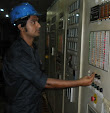PLC and Automation
A programmable logic controller, also called a PLC or programmable controller, is a computer-type device used to control equipment in an industrial facility. The kinds of equipment that PLCs can control
are as varied as industrial facilities themselves. Conveyor systems, food processing machinery, auto assembly lines…you name it and there’s probably a PLC out there controlling it.
In a traditional industrial control system, all control devices are wired directly to each other according to how the system is supposed to operate. In a PLC system, however, the PLC replaces the wiring between the devices. Thus, instead of being wired directly to each other, all equipment is wired to the PLC. Then, the control program inside the PLC provides the “wiring” connection between the devices.
The control program is the computer program stored in the PLC’s memory that tells the PLC what’s supposed to be going on in the system. The use of a PLC to provide the wiring connections between system devices is called softwiring.
APPENDIX
are as varied as industrial facilities themselves. Conveyor systems, food processing machinery, auto assembly lines…you name it and there’s probably a PLC out there controlling it.
In a traditional industrial control system, all control devices are wired directly to each other according to how the system is supposed to operate. In a PLC system, however, the PLC replaces the wiring between the devices. Thus, instead of being wired directly to each other, all equipment is wired to the PLC. Then, the control program inside the PLC provides the “wiring” connection between the devices.
The control program is the computer program stored in the PLC’s memory that tells the PLC what’s supposed to be going on in the system. The use of a PLC to provide the wiring connections between system devices is called softwiring.
APPENDIX
CASE STUDY
TOTAL TUTORIAL ABOUT PLC WILL BE PUBLISHED VERY SOON.....STAY WITH US
- Try to develop a relay based controller that will allow three switches in a room to control a single light.
- Develop a program with twomotors and relay. Conditions are, motor-2 will be run after a given time whenmotor-1 starts and both motors will be stopped when one stop signal given.
TOTAL TUTORIAL ABOUT PLC WILL BE PUBLISHED VERY SOON.....STAY WITH US







